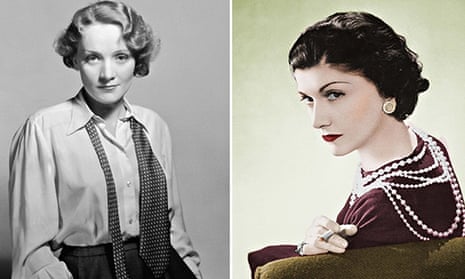Twiggy: defiant in a two-piece suit
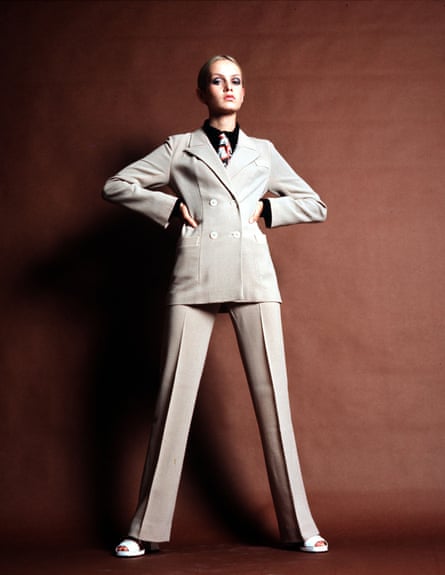
This isn’t a perfect look, but that’s why I like it. Twiggy should be wearing heeled brogues, or at least some shoes that are closed at the front. Those white clip-clop heels are designed to go with a casual kaftan and big shades, for standing on the edge of a swimming pool pointing out leaves to the pool boy. And the suit is made of horrible 60/70s material that shows the “invisible” hem and keeps the crease in the trousers, no matter what Twiggy gets up to. I enjoy all of these slightly crap things. I don’t like it when people are immaculate. You can’t see their character.
I’ve always thought that it’s the masculine side of women and the feminine side of men that are the interesting, sexy bits, and the late 60s saw conventional gender roles begin to shake themselves up. It’s quite an obvious thing to do for a woman, to dress like a man to show you’re strong, but it works. Women in men’s suits – as opposed to those weird, feminised, pastel-power lady suits – look brilliant.
Twiggy always looks amazing, but, in the late 60s, she was usually styled to appear young and kooky, spacey and unable to deal with life. This look is the opposite. She looks defiant and tough, despite her youth. Hands on her hips, like a boss, or a matriarch. Also, a bit bored. God, I love an impatient woman. Miranda Sawyer
Dynasty: a shoulder pad too far?
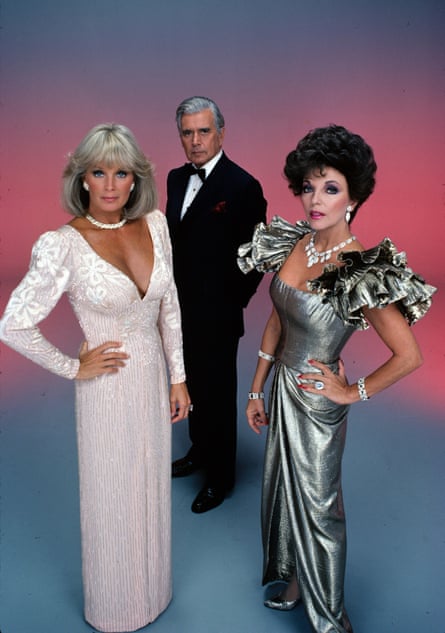
Throughout the 1980s, my mum would be watching Dynasty in the sitting room, telling me that it was rubbish, that she didn’t know why she bothered with it, that I should go to bed. And so we would sit together, glued to the sight of Joan Collins playing Alexis Carrington, the scheming ex-wife of the oil baron, and Linda Evans playing Krystle Carrington, the boring new one. Krystle, with her white hair and white dresses, was supposed to be the good angel, but I soon learned that the diabolical one with dramatic lipstick, bigger shoulderpads and even more hairspray would always steal the show. The way she would turn up at the worst moment, wearing the fur of an animal she had possibly just killed. That time she went to prison and got dragged around in her red cocktail dress with one shoulder strap. Power dressing looked like hard work all round though – I could never understand why these people from America, which I thought was supposed to be a young and fun and free sort of place, would trap themselves in a clothing performance more elaborate than my grandmother’s. I couldn’t see the point of any of it when you could just pull on a jumpsuit and enjoy your life. I still can’t. Sophie Heawood
Marlene Dietrich: hands free

This look is so incredibly modern, it’s impossible to believe it was taken 82 years ago. The clothes are central to that. It is not the fact that Marlene Dietrich is wearing mannish clothes, it’s the fact that she’s taken them and adapted them and made them her own. It could be a man’s or a woman’s world, but there’s no doubt Dietrich is in charge here. It’s smart, but brilliantly subversive at the same time. She has taken the phallic symbol of a necktie, and turned it into something open and sensual and feminine. The creamy silk is as flattering to her complexion as a string of pearls, and gives her an ice-queen, regal air. The fact that she’s wearing trousers with pockets allows her to adopt this pose, hands thrust into pockets, which is such a comfortable, natural look. Throughout art history women in portraits have their hands arranged to show off their delicate paleness and rich jewellery, but this turns all of that upside down. Oh, and also – I’d wear this look tomorrow.
Jess Cartner-Morley
Vidal Sassoon, Mary Quant and a haircut for a new era
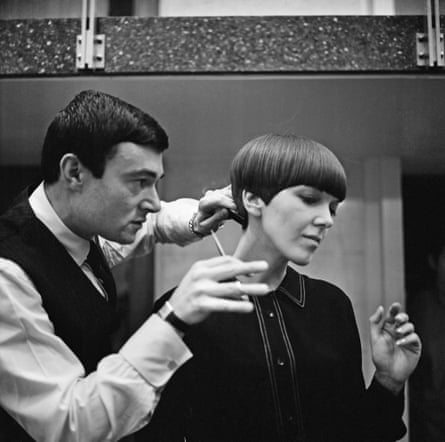
In both Vidal Sassoon and Mary Quant we see two fashion visionaries whose work represented a revolution in how women looked (as Quant says to Sassoon in the documentary of his life, Vidal Sassoon: The Movie: “I made the clothes, but you put the top on”). Quant’s clothes were never demure, respectable or well behaved. For the first time, young women didn’t need to shuffle around in needlessly large hooped skirts and uncomfortable corsetry – they had fun, streamlined clothes to run amok in. Sassoon gave Quant this haircut, an early version of his iconic chin-bob (a modernised version of the Louise Brooks, from the 1920s), in 1964, and in doing so, turned the tide for women and beauty. Previously, women had visited the salon weekly for a set, slept in uncomfortable rollers, had been unable to swim, bathe, walk in the rain – all for fear of ruining their stiff, impractical hairstyles. Sassoon gave them easy-to-style cuts with absolutely no regard for what your mother or potential boyfriends thought. His hairstyles were about beauty for normal women to please themselves, which is always the best kind. Sali Hughes
Angela Merkel: Well-defended against slings and arrows

Her face is slightly creased with mental exertion, but she’s not perturbed. Angela Merkel had just finished an interview with ARD television in August 2010. Her ratings were low at the time, despite the perception that she had come out on top of the Eurozone crisis, but she is quite well-defended against those kinds of slings and arrows. I love the awkwardness of her face, the contrivance of her hands, arranged as if she’s in a hardware store, demonstrating what size piece of wood she wants.
What you can see, as clearly as the imposing Reichstag building, is the benign impatience. “Why are you taking my photograph?”, her expression asks, obliquely. “Can’t you see I have work to do?” There’s a utilitarianism that reaches from her evasive impatience down to her comfortable shoes. “Back to work,” it all says. “Stop looking at me, and let’s all get back to work.” Zoe Williams
Choice in the changing room
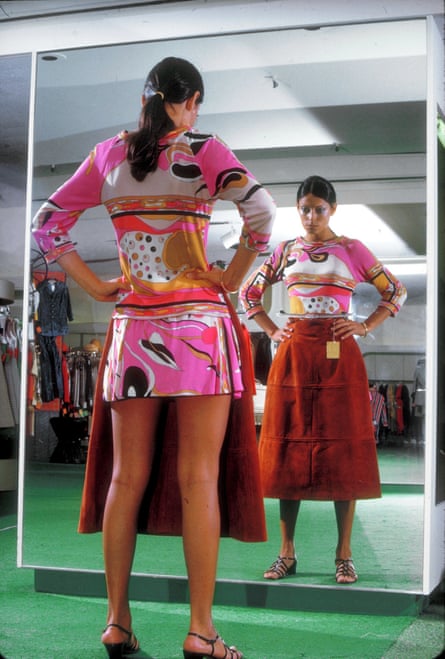
I love this photo because of the significance of the two lengths showcased: the short, brightly patterned dress (is it Pucci?) at the back, and the much more sombre midi skirt held in front of the subject’s body. The mini as cultural artefact is legend: in the 50 years since its invention, a lot has been written about it. It’s even possible that even too much has been written. And the story of how WWD editor John Fairchild essentially tried to sell the new length to the American skirt-buying public is as fascinating as the skirt’s length itself.
For me, this image is as clear a story as any we women have been wanting to tell for eons: our bodies are nobody’s but our own. And we can choose to clothe them in anything we wish. Our power – and the power of this photograph – lies in exercising that choice. This young woman in a shop in January 1970, with the second wave in full swing (Germaine Greer published The Female Eunuch that year), and her serious expression and her assured stance, would rock either look. This is what power looks like. Bim Adewunmi
Germaine Greer: Head over heels
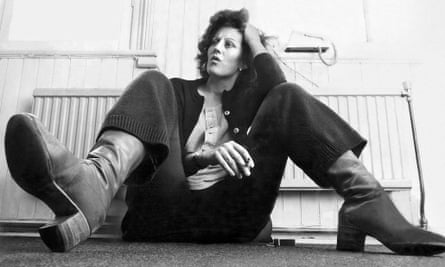
Look at her. Just LOOK AT HER. Here is a woman who just couldn’t care less what you think about her, and even though that makes her look even more cool, even more awesome, she doesn’t care about that either. It looks like this was taken in 1975, which means this is five years on from the publication of The Female Eunuch, a publication from which the world has never really recovered. It’s easy to dismiss Germaine Greer now: batty, bullish and tainted by reality TV. But that is to take a very short-term view of the woman. In the 1970s, there were few more fabulous than her: she was brilliant, she was fearless and, god DAMN, the woman had a mouth on her. Look at her here, not caring a jot that the photographer is basically taking a photo of her crotch. Good, she probably thought! Remind the world I’m no female eunuch! “I am a woman, not a castrate,” she famously wrote. She is more than just a woman, as this photo captures. She is the one and only Germaine Greer. Hadley Freeman
Coco Chanel: from corsets to comfort
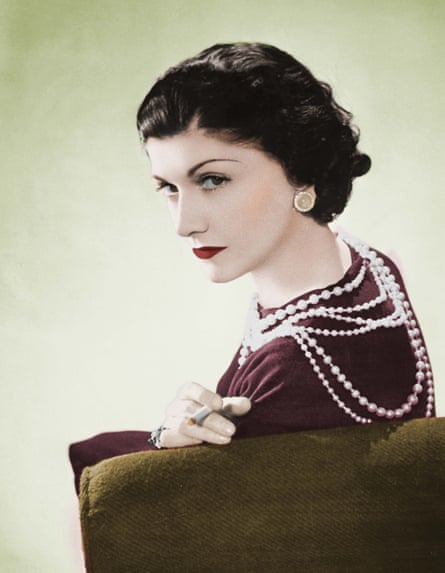
Coco Chanel changed women’s lives and gave them the freedom to move and enjoy the things that only men could do. She was the first designer to introduce clothing without the constraints of corsets. She borrowed from menswear and emphasised comfort stating that “luxury must be comfortable, otherwise it is not luxury”.
She famously styled a dress out of an old piece of jersey, and wore it causing many women to ask her to design them something similar. She stole the Breton stripe from the French working man, and turned it into a classic for women around the world, and her designs for the Ballets Russes in 1924, were decades ahead of her time, and wouldn’t look out of place today.
She was bold and daring, stepping out in a simple black silk shift to the ankle, whilst all around her were strapped into tight bodices with petticoats, she began a revolution in women’s clothing. The Little Black Dress is still as relevant today as it was when she first created it. Jane Shepherdson, chief executive, Whistles
Jess Cartner-Morley on Women Fashion Power
